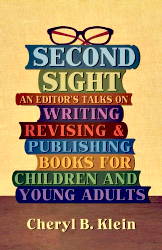Review of Second Sight
An Editor's Talks on Writing, Revising, & Publishing Books for Children and Young Adults
by Cheryl Klein
Contents
| Comments | To Buy
Purple
Crayon Bookstores
Book
Reviews Index Page

|
|
How does an editor work with a writer, and help her improve a manuscript? What does an editor think about plot and character and theme and how they must work together to produce a great story? And what are editors like as people? To find answers to these questions, children's book writers have always had to attend conference, read interviews and blog posts, and trade anecdotes and gossip. No longer--they can simply read Second Sight, in which editor Cheryl Klein of Scholastic's Arthur A. Levine Books publishes several year's accumulation of insightful articles and conference presentations.
| Let people know: |
Contents of Second Sight : Klein compiled the book from keynotes, presentations, workshops, blog posts, and how-tos that she created from 2003 to 2010. There is a variety of material, providing practical advice for writers, insight into the work that an editor does, and observations on children's book publishing. As she acknowledges, some pieces cover the same ground, but the book seldom feels repetitive. Practical material includes query letters, the process of writing a picture book, how to make a book dummy, character creation and charts, revision techniques, and so on, all focused on the task of making stories better. Philosophical musings explore what good writing is, the definition of a YA novel, keeping the reader engaged, what we can learn from the Harry Potter stories (she helped edit some of the books and knows the series very well), and the author-editor relationship.
More personally, Klein reveals what led her into her career as a children's book editor, and gives details of the careful line-editing and analysis that she provides for the books she edits. She is both rigorous and passionate about what she does, but is not above a humorous approach, as when she discusses how finding an editor is like dating.
To give detailed examples of the contents: Klein pairs "The Annotated Query Letter from Hell" with "An Annotated Query Letter That Worked." The first was created for her by an editorial friend in response to her complaints about what she does not want to see in a query letter, while the second is an actual query letter she received from the author of a manuscript that was published as Eighth Grade Superzero. The annotations not only give great practical advice about query letters but reveal much about Klein's tastes and personal interests--a combination of the practical and the personal. Or take a look at "Quartet: Four Elements of Fiction," which combines her philosophical musings about point, character, plot, and voice with some extremely practical hands-on exercises and worksheets.
Comments I could go on and on with more examples from the book, in an effort to show just how unusual and useful and difficult to categorize it manages to be. This is not a writing guide--though it contains a sizable amount of very helpful material for writers--because it goes beyond being a writing guide to get its readers thinking about the elements of good children's and YA literature, and to provide insight into the publishing process and the interests and personality of one particular editor. As such it's a great foil to my own Complete Idiot's Guide to Publishing Children's Books, which provides a more comprehensive overview of the practicalities of publishing, but doesn't get as much into writing or my personal interests; or to Jim Giblin's Guide to Writing Children's Books, which concentrates on writing
Who Needs Second Sight: If you are interested in getting some insight into the editorial process, or in musing over the requirements for good fiction, or in learning some practical revision techniques, or in finding out what the couch an editor's apartment looks like, this is the book for you. I have never before come across a book in which a children's book editor does all of these things. So I think writers of children's and YA books will be interested, but I suspect that editors will be as well, and that librarians and teachers will appreciate what Klein has to say about what makes a children's book tick.
As an update, note that Second Sight is now out of print. I recommend, instead, Klein's excellent The Magic Words: Writing Great Books for Children and Young Adults, which covers some of the same ground and then continues on. You can buy The Magic Words through Bookshop, an online bookstore that supports independent bookstores.
Where and How to Purchase Second Sight:
- Buy Second Sight at Amazon. It is out of print but available used.
Disclosure: I know Cheryl Klein personally, which may predispose me to liking this book. I earn commissions on purchases of books via links on this site, as explained on my policy page.
This review is copyright © by Harold Underdown ( Google + Profile ). If you wish to reproduce it, please see the Terms of use. Last modified 3/23/2021.